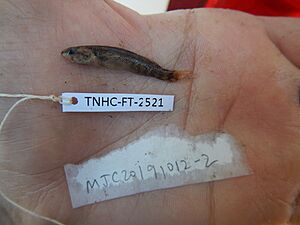Mud darter facts for kids
Quick facts for kids Mud darter |
|
|---|---|
 |
|
| Conservation status | |
| Scientific classification | |
| Synonyms | |
|
The mud darter (Etheostoma asprigene) is a small, freshwater fish. It's a type of ray-finned fish called a "darter." Darters belong to the same family as perches. You can find mud darters in the lowlands of the Mississippi River basin. They live from Wisconsin and Minnesota down to Louisiana and East Texas. They also live in rivers like the Sabine and Neches River in Texas and Louisiana. These fish like slow-moving water. They often eat tiny insect larvae. Most mud darters grow to about 5 cm (2.0 in) long. Some can reach up to 7.1 cm (2.8 in).
Contents
What's in a Name?
A scientist named Stephen Alfred Forbes first described the mud darter in 1878. The name of its group, Etheostoma, comes from two ancient Greek words. Etheo means "strain," and stoma means "mouth." The species name, asprigene, means "rough cheek." This name describes how the fish has scales covering its cheeks.
What Does a Mud Darter Look Like?
The mud darter has a mouth at the very front of its head. It has small teeth on its jaws. Its back is usually olive or brown. It has 8 to 11 dark spots, like saddles, across its back. Along its sides, you can see 9 to 12 dark brown bars. The base of its tail has three spots stacked on top of each other. The mud darter's belly is often a light cream or olive color. Most of these fish are about 5 cm (2.0 in) long. The biggest ones can be up to 7.1 cm (2.8 in).
The tail fin of a mud darter is usually rounded or square. It has two top fins, called dorsal fins. The first dorsal fin has 10 to 12 stiff spines. The second dorsal fin has 10 to 14 soft rays. Unlike some fish, the mud darter does not have a small, fleshy fin called an adipose fin. Its bottom fin, the anal fin, usually has 2 spines and 8 or 9 rays.
Where Do Mud Darters Live?
Mud darters live across North America in the lowlands of the Mississippi River Basin. You can find them from Wisconsin and Minnesota all the way south to Louisiana and eastern Texas. They also live in rivers that flow into the Gulf of Mexico, like the Sabine River and Neches River in Louisiana and Texas.
These fish prefer the mouths of large rivers and areas where rivers overflow. They often live over muddy bottoms covered with sand or other fine bits of material. You might also find them in muddy areas of oxbow lakes. They can also live in slow-moving parts of streams. Many mud darters have been seen hiding among the fine tree roots along the edges of big rivers. Young mud darters often prefer calmer waters than the adults.
What Do Mud Darters Eat?
Mud darters mostly eat small creatures without backbones, called invertebrates. Their main diet includes the young forms (larvae) of midges and blackflies. Some smaller mud darters have also been seen eating tiny crustaceans.
Mud Darter Life Cycle
Mud darters do not live very long, usually less than three years. After they hatch, they grow quickly. In about ten weeks, they reach half their size for their first year. By the end of their first year, most are between 3.3 cm and 4.4 cm long. By the end of their second and third years, they average between 4.3 cm and 5.5 cm.
About 75% of males and 81% of females survive from their first to their second year. However, fewer survive to their third year. Only about 14.5% of males and 12.1% of females live from their second to their third year.
Mud Darter Reproduction
The spawning season for mud darters is from early March to early or mid-May. Females are ready to lay eggs when they are one year old. During this time, male mud darters do not claim specific areas. However, they do become more aggressive towards other males.
When a male wants to mate, he swims around a female with his top fin standing up. Sometimes, he rests his head on her neck. The female chooses the spot where they will lay eggs, and the male follows her. The female goes into plants or weeds headfirst. Then, the male positions himself over her, curving his body into an S-shape. They both vibrate for a few seconds. The female then releases 5 to 10 eggs, which fall onto the ground or a plant. The pair will repeat this process many times, resting for a few minutes to half an hour between each time.


